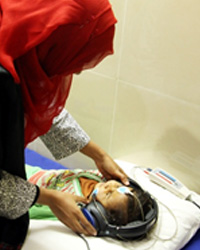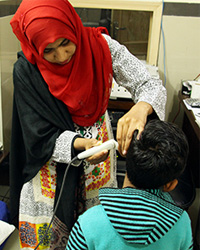Children with a cleft palate can have a higher chance of ear infections and hearing difficulties than children without a cleft palate. This is because of a structure called the eustachian tube. The eustachian tube allows the inside of the ear to drain any fluid out into the back of the nose. Because of the abnormal position of the muscles and tendons in children with cleft palate, the eustachian tube cannot drain the ear as well as in children without a cleft palate and can lead to higher risks of middle ear infections.
For this reason, it is important for children with cleft palate to have regular hearing checkups. The audiology department at the hospital provides services like Audiometry and Tympanometry which helps to diagnose and treat hearing defects.
Children with cleft palate are more likely than most children to experience hearing problems during the early years of life due to a condition called glue ear.Glue Ear is caused by eustachian tube dysfunction. The eustachian tube connects the ear and throat and equalizes pressure in the middle ear space, behind the ear drum. If this tube doesn’t open and close properly then the middle ear space can fill with liquid(known as glue ear). This can have an effect on hearing and subsequently, speech development.It is important that your child’s hearing is checked regularly (until aged 5) and you can attend a local audiologist for assessment. If glue ear is detected for a significant period, then your child may be referred to the Ear, Nose and Throat surgeon for further management (usually grommets and/or hearing aids).
All the patients who have a cleft palate must undergo assessment at the following stages:
Pre-op hearing assessment
Post-op assessment at year 1
Hearing assessment at year 3
Hearing assessment at year 5




